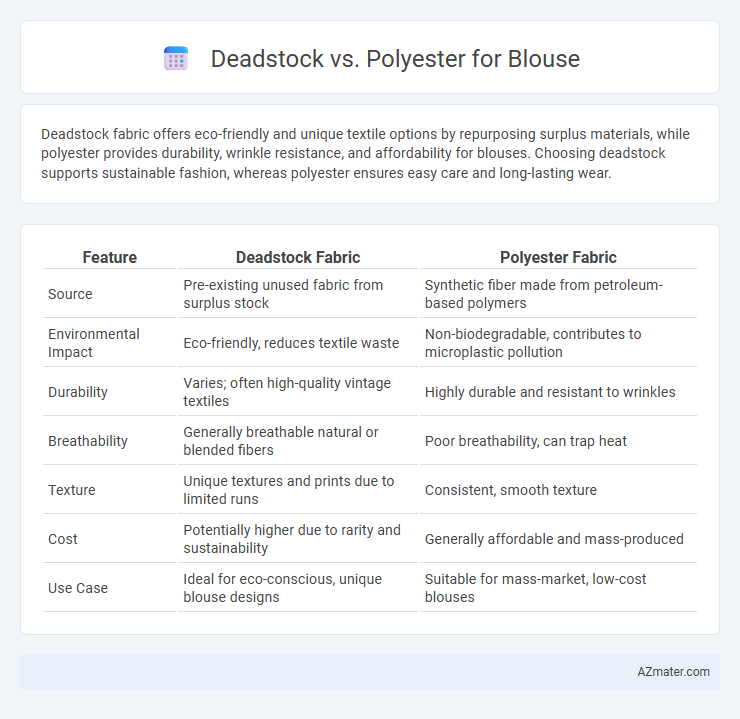Deadstock fabric offers eco-friendly and unique textile options by repurposing surplus materials, while polyester provides durability, wrinkle resistance, and affordability for blouses. Choosing deadstock supports sustainable fashion, whereas polyester ensures easy care and long-lasting wear.
Table of Comparison
| Feature | Deadstock Fabric | Polyester Fabric |
|---|---|---|
| Source | Pre-existing unused fabric from surplus stock | Synthetic fiber made from petroleum-based polymers |
| Environmental Impact | Eco-friendly, reduces textile waste | Non-biodegradable, contributes to microplastic pollution |
| Durability | Varies; often high-quality vintage textiles | Highly durable and resistant to wrinkles |
| Breathability | Generally breathable natural or blended fibers | Poor breathability, can trap heat |
| Texture | Unique textures and prints due to limited runs | Consistent, smooth texture |
| Cost | Potentially higher due to rarity and sustainability | Generally affordable and mass-produced |
| Use Case | Ideal for eco-conscious, unique blouse designs | Suitable for mass-market, low-cost blouses |
Understanding Deadstock Fabric
Deadstock fabric refers to unused, surplus textiles from previous production runs, often vintage or limited in quantity, making them a sustainable choice for blouses. Polyester, a synthetic fiber derived from petroleum, offers durability, wrinkle resistance, and moisture-wicking properties but lacks the unique character and eco-friendliness of deadstock materials. Utilizing deadstock fabric for blouses reduces waste and supports circular fashion by repurposing existing resources instead of relying on new, synthetic polyester production.
What Is Polyester Fabric?
Polyester fabric is a synthetic material derived from petroleum-based products, known for its durability, resistance to shrinking and stretching, and quick-drying properties. In comparison to deadstock fabric, which consists of leftover or surplus textiles often made from natural fibers, polyester offers greater wrinkle resistance and easier maintenance for blouses. Polyester's moisture-wicking abilities and affordability make it a popular choice in fashion, although deadstock fabrics appeal to eco-conscious consumers seeking unique, sustainable clothing options.
Environmental Impact: Deadstock vs Polyester
Deadstock fabric significantly reduces textile waste by repurposing surplus materials that would otherwise end up in landfills, making it an eco-friendly choice for blouses. Polyester production relies heavily on petroleum, resulting in high carbon emissions and non-biodegradable waste that contribute to long-term environmental degradation. Choosing deadstock over polyester for blouses supports sustainable fashion by minimizing pollution and conserving natural resources.
Blouse Comfort and Breathability
Deadstock fabrics offer superior breathability and comfort for blouses due to their natural fibers and less synthetic treatment compared to polyester. Polyester blouses often retain moisture and restrict airflow, leading to reduced comfort in warm conditions. Choosing deadstock over polyester enhances blouse wearability by promoting better ventilation and skin comfort.
Durability and Longevity Comparison
Deadstock fabric, often made from high-quality natural fibers, generally offers superior durability and longevity compared to polyester, which is a synthetic material prone to wear and pilling over time. Polyester blouses typically resist wrinkles and stains better but may degrade faster with frequent washing and exposure to heat. Investing in deadstock fabrics for blouses ensures not only eco-friendly fashion choices but also garments that maintain structural integrity and appearance longer than typical polyester options.
Style Versatility: Deadstock vs Polyester
Deadstock fabric offers unique, vintage-inspired patterns and textures that enhance blouse style versatility by providing one-of-a-kind looks not found in mass-produced polyester. Polyester blouses excel in consistency and color retention, making them ideal for a wide range of styles from casual to formal wear due to their easy care and wrinkle resistance. Combining deadstock's distinct aesthetic with polyester's durability can result in versatile blouses suitable for diverse fashion preferences and occasions.
Price and Accessibility
Deadstock fabric offers unique, limited-edition textiles sourced from leftover stock, often priced higher due to rarity and sustainable appeal. Polyester blouses are widely accessible and budget-friendly, benefiting from mass production and synthetic fiber affordability. Consumers seeking exclusivity may prefer deadstock despite a steeper price, while polyester ensures accessibility and cost-effectiveness for everyday wear.
Ethical Considerations for Buyers
Deadstock fabric offers a sustainable alternative by repurposing unused, surplus textiles, significantly reducing waste and lowering environmental impact compared to polyester, which is derived from non-renewable fossil fuels and contributes to microplastic pollution. Buyers prioritizing ethical fashion often favor deadstock blouses for their support of circular economy principles and minimized carbon footprint. Polyester blouses, while affordable and durable, present challenges in biodegradability and ecological harm, making them less ideal for environmentally conscious consumers.
Care and Maintenance Tips
Deadstock fabric requires gentle care methods such as hand washing in cold water and air drying to preserve its vintage texture and prevent damage. Polyester blouses are low-maintenance, typically machine washable, and resistant to wrinkles, but should be dried on low heat to avoid melting fibers. Proper care extends the lifespan of both fabrics, ensuring color retention and fabric integrity.
Which Fabric Is Better for Blouses?
Deadstock fabric offers an eco-friendly and unique option for blouses, often featuring high-quality, limited-edition textiles sourced from unused inventory. Polyester is a durable, wrinkle-resistant synthetic fabric that provides affordability and easy care but may lack breathability compared to natural or deadstock fibers. Choosing the better fabric depends on priorities such as sustainability and exclusivity favored by deadstock or the practicality and cost-effectiveness offered by polyester.

Infographic: Deadstock vs Polyester for Blouse
 azmater.com
azmater.com